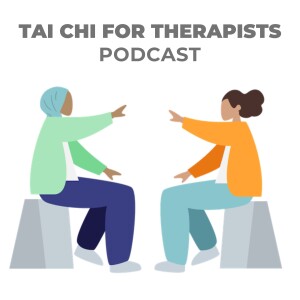
Monday Feb 17, 2025
Ep.06 Merging Movement Into Occupational Therapy Practice With Ali Leigh
Welcome to episode six of the Tai Chi for Therapists podcast. In this episode we talk with Ali Leigh, an Occupational Therapist based in Sussex.
In Ali's own words,
“I am deeply passionate about my role as an Occupational Therapist. It’s a privilege to use the therapeutic power of movement to enhance the mental and physical wellbeing of my clients. I also offer Yoga (both full and seated practices) and Tai Chi in NHS hospitals, schools, and private practice settings.
As a Return to Practice OT, I’ve embarked on an incredible journey to carve out my niche—integrating Occupational Therapy with the transformative benefits of Yoga and Tai Chi.
I’m also passionate about empowering fellow OTs to confidently incorporate movement-based activities into their clinical practice. If you’d like to explore how we can work together or if I can support you in any way, please don’t hesitate to reach out.”
Instgram: @alison.otandyoga
Interview Summary
1. Integration of Tai Chi and Yoga in Occupational Therapy (OT):
- Ali, an occupational therapist, discusses her journey of integrating Tai Chi and Yoga into her OT practice, particularly in mental health and educational settings.
- She emphasizes the importance of movement-based therapies in expanding patients' lives, especially those experiencing sensory deprivation or limited mobility.
2. Benefits of Movement-Based Therapies:
- Tai Chi and Yoga are highlighted for their ability to help patients reconnect with their bodies, improve mobility, and enhance mental well-being.
- These practices are particularly effective for individuals who may feel disconnected from their bodies due to age, mental health issues, or physical limitations.
3. Application in Different Settings:
- Mental Health: Ali used these practices in community mental health settings to help patients expand their world and improve their sensory experiences.
- Schools: She collaborated with PE departments to introduce Tai Chi and Yoga to children, particularly those who struggled with traditional PE classes. This helped children feel more included and confident in their movement abilities.
- Acute and Older Adult Wards: Ali implemented these practices in hospital settings, where even patients who initially observed from the periphery eventually engaged and benefited from the sessions.
4. Embodiment and Reconnection:
- Both Tai Chi and Yoga help patients reconnect with their bodies, which can be especially powerful for older adults or those with chronic conditions. For example, one elderly patient expressed joy at "feeling her legs again" after participating in Tai Chi.
5. Non-Threatening and Accessible:
- Tai Chi is particularly noted for being non-threatening and accessible, making it easier for patients with limited mobility or confidence to engage in movement therapy.
- Unlike Yoga, which some patients perceive as requiring high flexibility, Tai Chi is seen as more approachable, especially for older adults or those with physical limitations.
6. Professional Collaboration and Evidence-Based Practice:
- Ali worked closely with senior OT staff and hospital managers to implement these practices, using evidence-based research to support her approach.
- She emphasizes the importance of collecting data and sharing evidence to ensure these practices are embedded in clinical settings.
7. Future Directions:
- Ali is exploring opportunities to integrate Tai Chi and Yoga into tennis programmes for older adults, in collaboration with the Lawn Tennis Association (LTA) and Age UK. This would combine physical activity with movement therapy to enhance overall well-being.
- She is also looking to expand her reach through social media and training other OTs in these practices.
8. Advice for Health Professionals:
- Ali encourages health professionals to start small, even 10-15 minutes of movement can be beneficial.
- She advises seeking training in Tai Chi and Yoga to confidently integrate these practices into therapy sessions.
- Building a community of practice with other OT's and health professionals is crucial for support and sharing best practices.
Applicability for Health Professionals:
- Movement-Based Therapies: Health professionals, especially OTs, can consider incorporating Tai Chi and Yoga into their practice to help patients with physical and mental health challenges.
- Evidence-Based Approach: Collecting data and presenting evidence can help gain support from colleagues and management for implementing these therapies.
- Patient-Centered Care: Tailoring movement therapies to individual patient needs can help them reconnect with their bodies and improve their quality of life.
- Collaboration: Working with other professionals and organizations (e.g., schools, sports clubs) can expand the reach and impact of these therapies.
In Summary
Ali highlights the practical applications and benefits of Tai Chi and Yoga in various healthcare settings, offering actionable insights for health professionals interested in integrating these practices into their work.
Listen, rate, and subscribe.
Have you enjoyed this episode? Please take a moment to rate and subscribe, it really helps us keep the podcast going.
Would you like to find out more about our class leading CPD course for health professionals: Tai Chi for Therapists.
We created this course for all registered allied health professionals, clinicians, and other rehabilitation professionals who would like to learn how to implement evidence-based tai chi and qigong movements into their clinical practice.
If you’re a physiotherapist, physical therapist, occupational therapist, occupational or physiotherapy assistant, or other allied health professional visit our course page to find out more.
We look forward to seeing you,
Phil & Helen
Website: www.taichifortherapists.com
No comments yet. Be the first to say something!